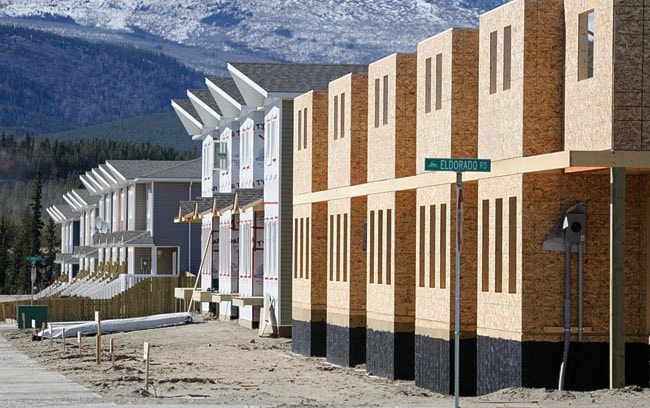A high-ranking health official once warned that a massive continuing care facility in the sparsely-occupied Whistle Bend subdivision would be a “nightmare and will haunt the government.”
These warnings, in the end, didn’t deter the Yukon government from proceeding with these plans. Internal documents shed some light on the controversial decision to put 300 beds in the city’s newest subdivision.
Tamara Goeppel filled out an access-to-information request that obtained these documents because she says she wanted to understand how the Whistle Bend site was chosen.
“When I talk to seniors and I talk to elders and I talk to the families, it just didn’t seem to make sense that Whistle Bend was chosen.”
Goeppel shared the documents with the CBC, and some of them have been made public.
What she found was Whistle Bend somehow went from a last choice to a possible second choice, to the final choice - all while Porter Creek appeared to have much more going for it.
According to a “confidential advice to the minister” memo completed by the Department of Public Works in April 2014, four sites were originally considered for the facility - in Porter Creek, Riverdale, Copper Ridge and Whistle Bend.
When a geotechnical study was done that month, Porter Creek came out on top and Whistle Bend was in last place.
In Whistle Bend there are issues with silt, a basement is not recommended and the area is susceptible to frost heaves.
On April 9, 2014 - five days after the geotechnical report -“instructions were provided by the senior management that sites in Porter Creek, Riverdale and Copper Ridge should be taken off the table for any further work, whereas the site in Whistle Bend remains under the scope,” according to the memo.
There’s no information on why that decision was made.
The Public Works memo “highly recommends” that the Porter Creek site be added back into the discussion.
Other sites - a spot on Range Road and the north end of the tank farm - were added to the list but eliminated.
So far, the Yukon Party isn’t directly commenting on the matter.
Aside from a short statement saying “this government values the hard work and collaboration of officials who have brought this project to this point,” Premier Darrell Pasloski was not available for an interview. He is expected to answer questions later today.
By July 2014 a business case analysis by T-Square Architecture Ltd. was made public and Porter Creek is back in contention.
Guidelines for the site included being in an established community, close to transit and the ability to integrate with local schools. It explicitly says the site should not be in a community under development - presumably like Whistle Bend - because of the disruption ongoing construction can cause.
The Porter Creek site, meanwhile, is next to Porter Creek Secondary School. It is in an established community with excellent transit and a bus stop right out front.
“Being located adjacent to a high school is ideal for community building, volunteer opportunities, and career training. It is also positive that the site is located in an established residential neighbourhood with existing transit service,” the report says.
The government anticipates that a new school will be built in Whistle Bend sometime between 2019 to 2024, along with commercial development and more housing.
“The Whistle Bend site would allow the new Whitehorse continuing care facility to become an ‘anchor tenant’ of Whitehorse’s newest neighbourhood. It is a suitable location for the new facility on many fronts although it can be said that a lot rides on the future and continued development of Whistle Bend.”
When it’s done, Whistle Bend is supposed to have 8,000 residents. But recent sales of lots have not gone well. Last month, none of the 50 lots in a lottery were sold. The report states that the city expected 1,000 residents to live in Whistle Bend by spring of this year.
For Goeppel, choosing Whistle Bend means choosing what could be over what is already established and that’s troubling.
“It was a highly slanted decision-making process to favour Whistle Bend and it really seemed to satisfy the agenda of government to finance and to populate an under-performing project as opposed to ask what the needs of the residents of a future continuing care facility are,” she said.
The report concludes that “with the exception of a slighter higher cost of the construction and the newness of the neighbourhood Whistle Bend is considered to be a viable second choice.”
Though Whistle Bend is actually listed as being a higher risk because of “unusually costly foundation work,” the report mentions in passing possible public resistance to the Porter Creek site,
“... Should anticipated public resistance to the project in Porter Creek be considered of paramount importance to the smooth, unencumbered overall progress of the project the Whistle Bend site may indeed be a preferred location by the majority of YG decision-makers.”
In an email exchange between officials before the report was released, Cathy Morton-Bielz, assistant deputy minister of continuing care, strongly disagrees with proceeding with the Whistle Bend site.
“From a program perspective (which is an important one) Whistle Bend lot is not a strong second (regardless of community opposition) because it is not in an established community.
“The optics of placing a care facility in an empty field is really a nightmare and will haunt the government for far longer than a bit of community opposition. There was lots of opposition to Copper Ridge Place going in - the neighbours are now delighted we are there. The same will happen if PC is chosen.”
Whistle Bend was announced as the location in December.
Contact Ashley Joannou at
ashleyj@yukon-news.com
